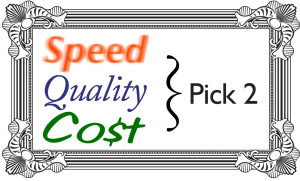Digital printing vs offset printing: how to choose the right process for your job
You’ve made the decision to include print in your marketing mix, but do you understand the printing options available and what might suit your needs? Like so many industries, how printing is done has been transformed with the advancement of digital technology. A push for quick turnarounds continues to drive the growth of on-demand printing. But even with these changes, more traditional offset printing remains a cost competitive and viable choice. The following checklists will help in selecting between digital vs offset printing for your job.
What is digital printing?
Printing directly to a digital ink jet or laser printer from a finished design file has been around for a while now and has continued to improve in quality. In fact, if your organization already has a decent in-house colour printer, it could be just fine for some small jobs such as a limited run of letter sized posters or invitations. However, you will likely need to consider your audience, limited paper stock choices, costs for ink and competing demands for printer time in your office if you go this route.
Sending a job out to a digital printer
There are now a wide variety of printing suppliers, including traditional print houses, who have digital printers with high-resolution capabilities. However, it’s important to be aware that there are limits with this evolving technology. You’ll need to weigh several factors when deciding to go the route of a digital printing job, including cost, design complexity and turnaround time. Remember that shortening the turnaround will often increase cost per unit.
Digital printing checklist
Does your job meet these criteria?
- Short turnaround (somewhere between 2-5 business days)
- Quantity of less than 500 (for smaller pieces such as 3 buckslips per page which require simple cuts, no more than 1,000)
- Design is a standard size such as letter, legal or tabloid with no bleeds (large format digital print specialists can be sourced for bigger pieces, but be aware that turnaround may be affected)
- Straightforward bindery (for example, trifold, cerlox binding or saddle stitch)
- Requires readily available and compatible standard paper stocks (specialty stocks will not work in the digital printing environment)
- Colour or black and white design
- No detailed final proof of colour or pagination required (sign off on a PDF file is acceptable)
- Average quality required
Printing jobs compatible with the digital process
Typically, jobs that work well with digital printing are small runs with straightforward designs. These could include pieces in standard sizes such as:
- three panel brochure
- poster
- flyer
- booklet requiring minimal bindery
- buckslip
In the past, it was wise to avoid full ink coverage because of possible smearing, but this issue has improved as the technology moves along. If you have concerns, ask the supplier if drying time will be a problem based on your design.
What is offset printing?
Offset lithography is formal name for a traditional printing process, which uses a combination of four ink colours – cyan, magenta, yellow and black – to create a full colour printed piece. Presses also have the capacity for custom inks also known as “spot colours” (sometime referred to as Pantone© or PMS colours) as well as coatings including varnishes. Offset refers to the way the printing press offsets layers of these colours onto rubber rollers, which are then impressed onto paper.
Sending a job to an offset printer
Sending a job out to an offset printer does require a properly colour separated file set up by your designer, so it’s important that they understand what process will be used to print the final design in advance. At the printing facility, printing time on the press must be booked, and a press operator runs the press and provides quality control, hence the longer turnarounds. Hard copy proofs provided by the printer are often an integral part of the process, so it’s advisable to have internal reviewers ready to verify and approve them for colour, design, pagination and copy accuracy to keep the job on schedule.
Offset printing checklist
Does your job meet these criteria?
- Longer turnaround (somewhere between 6-15 business days, but generally assume 10 business days)
- Pre-press work needed (colour correction etc.)
- Larger quantity (greater than 1,000 pieces, however with more complex pieces smaller quantities may also be more cost effective with offset)
- Design is a standard or a non-standard size with or without bleeds
- Standard or specialty paper stock required
- Design is black, full colour or includes a special spot colour
- Specialty coatings required (varnishes or UV coating)
- Specialty bindery required (could include unusual folds, die-cuts, booklet binding etc.)
- Hard proofs and proofing time required (if highly accurate colour or pagination is critical)
- Higher quality required
Printing jobs compatible with the offset process
Nonprofit print jobs that most often work well with offset include:
- large direct mail campaigns
- larger quantity runs such as information sheets or brochures
- booklets or pieces with special bindery or die-cuts
- magazines
- larger format items such as folders.
Your printer is your friend
As a nonprofit marketing professional, your marketing budgets will often dictate your choice of printing process, so it’s important to know in advance what you can expect from digital printing vs offset printing and advise your designer accordingly. Your printing supplier is an excellent resource to help you further understand the processes, choose paper, create mock ups and make the most of your donor dollars.



 PRINT
PRINT

